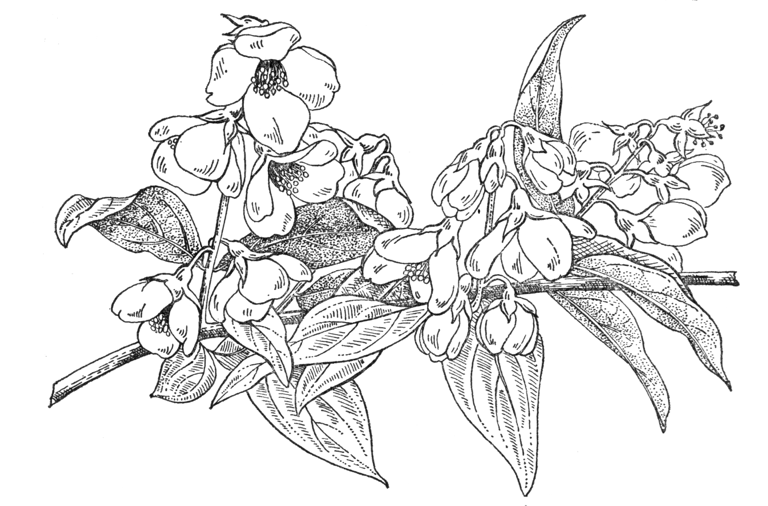A shrub up to 10 or 15 ft high; shoots glabrous or sometimes hairy. Leaves ovate, rounded at the base, slender-pointed, toothed, up to 4 in. long and 13⁄4 in. wide on the flowering twigs, but 6 to 7 in. long, 3 to 31⁄2 in. wide on the sterile growths, dark green and sparsely hairy above, rather densely coated with loosely appressed hairs beneath (but sparsely so in var. calvescens Rehd.). Flowers fragrant, 1 to 11⁄2 in. or slightly more wide, produced in racemes of seven to eleven. Petals pure white, roundish oval, often deeply toothed or undulated at the margins. Calyx glabrous outside, often tinged with purple and wholly plum-purple in f. melanocalyx (L. Henry) Rehd. Style glabrous, divided only at the apex.
Native of W. China, S.E. Tibet, and N. Burma; discovered and introduced by the Abbé Delavay in 1887. It first flowered in the Jardin des Plantes, Paris, in 1891. However, most of the plants now in British gardens were raised from seeds collected by George Forrest in W. Yunnan. Of these the best known is the ‘Nymans Variety’, in which the calyx is coloured an almost uniform plum-purple, and on this account would be referable to f. melanocalyx. It received an Award of Merit when shown from Nymans on June 18, 1935. Identical plants were, however, raised in other gardens from the seeds sent by Forrest, for example at Wakehurst Place, whence came the material figured in Bot. Mag., t. 9022. In this plant, as in those now in commerce as ‘Nymans Variety’ or var. calvescens, the leaves are sparsely hairy beneath, but the species varies in the degree of hairiness of the undersides of the leaves even in the same locality and, indeed, ‘typical’ plants with the undersides densely hairy and others with hairs of the same type but more sparse, have been raised from one and the same batch of wild seed.
P. delavayi, as represented in commerce, is a vigorous plant with strikingly large leaves. The flowers, borne from end-May or early June, are beautifully formed, saucer-shaped at first, becoming almost flat, their pure white petals contrasting with the richly coloured calyx.
P. purpurascens (Koehne) Rehd. P. brachybotrys var. purpurascens Koehne – This species is closely allied to P. delavayi and perhaps not separable from it. The best distinguishing character is provided by the leaves, which in wild material of P. purpurascens are scarcely more than 1 in. long on the flowering twigs and up to only 15⁄8 in. long on the sterile shoots (but slightly larger on some cultivated plants); they are almost glabrous above, and sparsely hairy beneath. The flowers are smaller (not much over 1 in. wide), and the petals are relatively narrower and more erect. The calyx is green or slightly tinged with purple. P. purpurascens was introduced by Wilson from W. Szechwan when collecting for Messrs Veitch and was figured in Bot. Mag., t. 8324, as P. delavayi.


